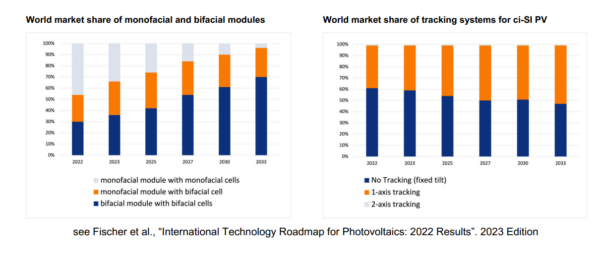Bifacial tracking systems have the lowest levelized cost of electricity (LCOE) for more than 90% of the world, according to the International Energy Agency's IEA-PVPS division.
Its Task 13 fact sheet, which focuses on bifacial tracking, explains that a combination of bifacial modules with single-axis tracking produces the cheapest electricity, as it increases energy output by up to 35% over conventional systems. It adds that cell designs in bifacial modules allow light to reach the cells from the rear side, with efficiencies from 60% to over 90% on the front side.
Bifacial PV cells and modules are overtaking the market share of monofacial PV technologies. IEA-PVPS forecasts that by 2033, bifacial modules with bifacial cells will account for more than 70% of the market. Trackers – particularly single-axis trackers – are also growing in market share, and are expected to surpass 50% market share by 2033.

IEA-PVPS says tracker companies are focusing on certain market sectors, such as dual-uses for agrivoltaics, deployment on nonagricultural or usable land, and highly sloped terrain. Figures from 17 tracker companies, equivalent to at least 87% of the global market share between 2012 and 2021, suggest that more than 80% of companies sell trackers in more than 10 countries.
The fact sheet includes an overview of system designs for optimal yield and value. Researchers found that all tracker companies surveyed offer backtracking, which adjusts tilt angles swiftly during adverse weather conditions like hail, snow, or strong winds to safeguard systems and modules.
The Task 13 working group of IEA-PVPS is currently studying best practices for bifacial tracking systems. This work involves conducting a blind PV performance modeling study where participants simulate six hypothetical PV systems using provided design and weather data. IEA-PVPS plans to publish a forthcoming report that will provide detailed insights to assist companies and developers in designing high-quality PV systems that consider all factors affecting performance.
The program's latest work follows the Task 12 fact sheet on the environmental lifecycle assessment of PV systems, which was released in June.
This content is protected by copyright and may not be reused. If you want to cooperate with us and would like to reuse some of our content, please contact: editors@pv-magazine.com.




By submitting this form you agree to pv magazine using your data for the purposes of publishing your comment.
Your personal data will only be disclosed or otherwise transmitted to third parties for the purposes of spam filtering or if this is necessary for technical maintenance of the website. Any other transfer to third parties will not take place unless this is justified on the basis of applicable data protection regulations or if pv magazine is legally obliged to do so.
You may revoke this consent at any time with effect for the future, in which case your personal data will be deleted immediately. Otherwise, your data will be deleted if pv magazine has processed your request or the purpose of data storage is fulfilled.
Further information on data privacy can be found in our Data Protection Policy.